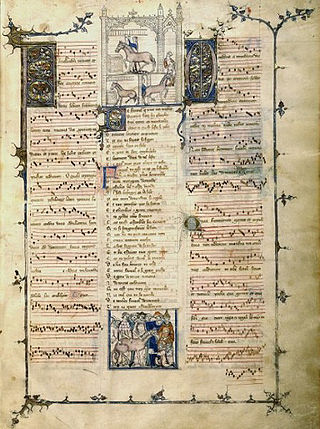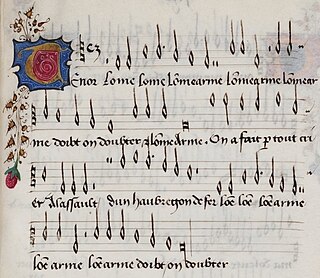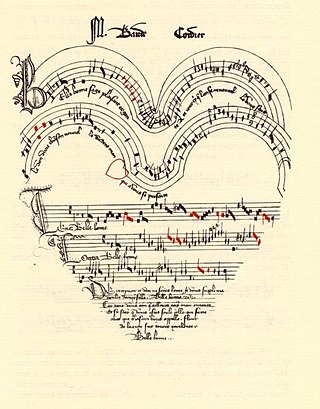Related Research Articles

Gilles de Bins dit Binchois was a Franco-Flemish composer of early Renaissance music. A central figure of the Burgundian School, Binchois and his colleague Guillaume Du Fay were deeply influenced by the contenance angloise style of John Dunstaple. His efforts in consolidating a 'Burgundian tradition' would be important for the formation of the Franco-Flemish School. One of the three most famous composers of the early 15th century, Binchois is often ranked behind Du Fay and Dunstable by contemporary scholars, but his works were still widely cited, emulated and used as source material after his death.

Johannes Ockeghem was a Franco-Flemish composer and singer of early Renaissance music. Ockeghem was the most influential European composer in the period between Guillaume Du Fay and Josquin des Prez, and he was—with his colleague Antoine Busnois—the leading European composer in the second half of the 15th century. He was an important proponent of the early Franco-Flemish School.

Guillaume Du Fay was a composer and music theorist of early Renaissance music, who is variously described as French or Franco-Flemish. Considered the leading European composer of his time, his music was widely performed and reproduced. Du Fay was well-associated with composers of the Burgundian School, particularly his colleague Gilles Binchois, but was never a regular member of the Burgundian chapel himself.

John Dunstaple was an English composer whose music helped inaugurate the transition from the medieval to the Renaissance periods. The central proponent of the Contenance angloise style, Dunstaple was the leading English composer of his time, and is often coupled with William Byrd and Henry Purcell as England's most important early music composers. His style would have an immense influence on the subsequent music of continental Europe, inspiring composers such as Du Fay, Binchois, Ockeghem and Busnois.
A chanson is generally any lyric-driven French song. The term is most commonly used in English to refer either to the secular polyphonic French songs of late medieval and Renaissance music or to a specific style of French pop music which emerged in the 1950s and 1960s. The genre had origins in the monophonic songs of troubadours and trouvères, though the only polyphonic precedents were 16 works by Adam de la Halle and one by Jehan de Lescurel. Not until the ars nova composer Guillaume de Machaut did any composer write a significant number of polyphonic chansons.

Jehan le Taintenier or Jean Teinturier was a Renaissance music theorist and composer from the Low Countries. Up to his time, he is perhaps the most significant European writer on music since Guido of Arezzo.

Ars nova refers to a musical style which flourished in the Kingdom of France and its surroundings during the Late Middle Ages. More particularly, it refers to the period between the preparation of the Roman de Fauvel (1310s) and the death of composer Guillaume de Machaut in 1377. The term is sometimes used more generally to refer to all European polyphonic music of the fourteenth century. For instance, the term "Italian ars nova" is sometimes used to denote the music of Francesco Landini and his compatriots, although Trecento music is the more common term for the contemporary 14th-century music in Italy. The "ars" in "ars nova" can be read as "technique", or "style". The term was first used in two musical treatises, titled Ars novae musicae by Johannes de Muris, and a collection of writings attributed to Philippe de Vitry often simply called "Ars nova" today. Musicologist Johannes Wolf first applied to the term as description of an entire era in 1904.

The Burgundian School was a group of composers active in the 15th century in what is now northern and eastern France, Belgium, and the Netherlands, centered on the court of the Dukes of Burgundy. The school inaugurated the music of Burgundy.

Antoine Busnois was a French composer, singer and poet of early Renaissance music. Busnois and colleague Johannes Ockeghem were the leading European composers of the second half the 15th century, and central figures of the early Franco-Flemish School.

"L'homme armé" is a secular song from the Late Middle Ages, of the Burgundian School. According to Allan W. Atlas, "the tune circulated in both the Mixolydian mode and Dorian mode ." It was the most popular tune used for musical settings of the Ordinary of the Mass: over 40 separate compositions entitled Missa L'homme armé survive from the period.
Robert Morton was an English composer of the early Renaissance, mostly active at the Burgundian court. He was highly regarded at the time. Only secular vocal music, all rondeaux for three voices, survive.
Johannes Regis was a Netherlandish composer of the Renaissance. He was a well-known composer at the close of the 15th century, was a principal contributor to the Chigi Codex, and was secretary to Guillaume Dufay.
Fauxbourdon – French for false drone – is a technique of musical harmonisation used in the late Middle Ages and early Renaissance, particularly by composers of the Burgundian School. Guillaume Dufay was a prominent practitioner of the form, and may have been its inventor. The homophony and mostly parallel harmony allows the text of the mostly liturgical lyrics to be understood clearly.

Baude Cordier was a French composer in the ars subtilior style of late medieval music. Virtually nothing is known of Cordier's life, aside from an inscription on one of his works which indicates he was born in Rheims and had a Master of Arts. Some scholars identify him with Baude Fresnel, a harpist and organist in the court of Philip the Bold, though other scholars have rejected this.
Over 40 settings of the Ordinary of the Mass using the tune L'homme armé survive from the period between 1450 and the end of the 17th century, making the tune the most popular single source from the period on which to base an imitation mass.
The Loire Valley chansonniers are a related group of songbooks copied in the Loire Valley region of central France c. 1465-c. 1475 and produced in the context of the French royal court. They consist of six chansonniers: Copenhagen, Dijon, Nivelle, Laborde, Leuven and Wolfenbüttel. The songbooks, smaller than a modern paperback, personalized and lavishly decorated, are the earliest surviving examples of a new genre which offered a combination of words, music, and illuminations.

David Fallows is an English musicologist specializing in music of the late Middle Ages and early Renaissance, as well as the performance practice of music. He is a leader in fifteenth-century music studies, particularly secular song, Guillaume Dufay, and Josquin des Prez, both the subject of landmark biographies Fallows has written.
The Casanatense chansonnier was a major collection of Renaissance vocal music made in Ferrara c. 1480, including compositions from Europe's leading composers.
F. Rubinet, sometimes given as Robinet, was a French composer and singer active in Florence, Italy. Six compositions credited to F. Rubinet were copied in Florence in the 1490s and are extent in the collection at the National Central Library in Florence. Scholars speculate that this composer is the same person as a cantor, "Robinetto francioso cantore", employed at the Santissima Annunziata, Florence in 1482–1483, and a 'contro alto' "fratrem Rubinectum franciosum" employed at the Florence Cathedral in 1506–1507. His compositions appear to have been influence by Loyset Compère, and use a similar 'cycle of fifths' utilized in Compère's compositions.
References
- ↑ "Abyngton, Henry (ABNN463H)". A Cambridge Alumni Database. University of Cambridge. Retrieved 22 July 2020.
- ↑ Higgins, Paula, ed. (1999). Antoine Busnoys: Method, Meaning, and Context in Late Medieval Music. Oxford University Press. p. 552. ISBN 0-19-816406-8.
- ↑ Montagna, Gerald (1987). Fenlon, Iain (ed.). Early Music History 7: Studies in Medieval and Early Modern Music (2009 ed.). Cambridge University Press. p. 121. ISBN 978-0-521-74654-0.
- ↑ Archivio Storico Lombardo: Indici Anni I - XX. Milan: Societa Storica Lombarda. 1893. p. 107.
- ↑ Taruskin, Richard (1986). "Antoine Busnoys and the "L'Homme armé" Tradition". Journal of the American Musicological Society. 39 (2): 255–293. doi:10.2307/831531. JSTOR 831531.
- ↑ RISM 451509099 Der Wolfenbütteler Chansonnier
- ↑ Fallows, David (2001). "Binchois [Binchoys], Gilles de Bins [Binch, Binche] dit". Grove Music Online. Oxford University Press. doi:10.1093/gmo/9781561592630.article.03094.
- ↑ Fallows, David (2001). "Zacharie, Nicolaus". Grove Music Online. Oxford University Press. doi:10.1093/gmo/9781561592630.article.52676.